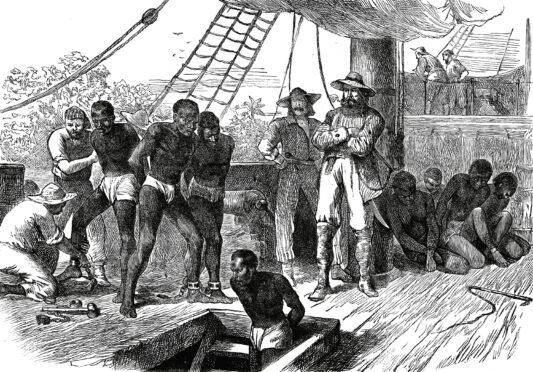
A major survey has been launched to gather in views on how Scotland’s museums and galleries should present the country’s links with slavery.
The evidence will be collated and used to make recommendations to the Scottish Government on how collections and exhibits should be used accurately and respectfully.
Museums Galleries Scotland, said: “The project is important to expanding and deepening Scotland’s understanding of history in all its complexity.”
Academic and human rights campaigner Sir Geoff Palmer, chairman of the steering group which will oversee the project, said: “The aim is to improve the role which our museums and galleries play in informing the public of Scotland’s historical links to chattel slavery, empire and colonialism and the significant contributions Scotland’s ethnic communities make to Scotland today.
“I am a descendant of chattel slaves who were enslaved in Jamaica from 1655 to 1838 and many of the slave plantations were owned by Scots.
“It is a great honour to chair this history-based project and I would ask people to support this consultation as the results will influence our recommendations to the Scottish Government.”
Museums Galleries Scotland said: “For more than 200 years, Scotland’s economy was closely tied to imperial trade and conquest.
“The wealth generated from the systems of chattel slavery and colonialism enriched Scotland at the expense of the places which were colonised.
“The legacies of colonialism remain today as do strong links between Scotland and its international diaspora.”
Abeer Eladany, Curatorial Assistant at University of Aberdeen Museums and a member of the Empire, Slavery & Scotland’s Museums Steering Group, said: “I am delighted the public is being offered a say in how they would like museums to address issues and collections connected to slavery, empire, and colonialism in museums across Scotland.”
Culture Minister Jenny Gilruth said: “Museums should be inclusive and accessible spaces, where anyone is able to explore challenging aspects of our history.
“I am pleased to support Museums Galleries Scotland in launching this important consultation, part of a two-year project, backed by £159,000 of Scottish Government funding.”
Work has been ongoing to audit street names and monuments in Glasgow with connections to the slave trade. It’s anticipated they could be amended to highlight such links.
The grave of economist and philosopher Adam Smith, widely regarded as one of Scotland’s greatest thinkers, has been included in a list of sites linked to slavery in Edinburgh.
The location, in Canongate Kirkyard on the Royal Mile, will form part of a review by Edinburgh city council of sites linked to “historic racial injustice”.
To participate, visit surveymonkey.co.uk/r/ESSM1

Enjoy the convenience of having The Sunday Post delivered as a digital ePaper straight to your smartphone, tablet or computer.
Subscribe for only £5.49 a month and enjoy all the benefits of the printed paper as a digital replica.
Subscribe